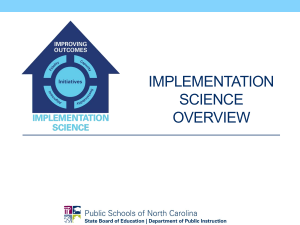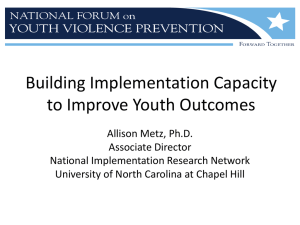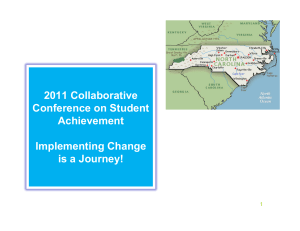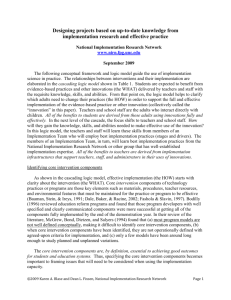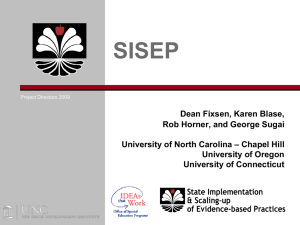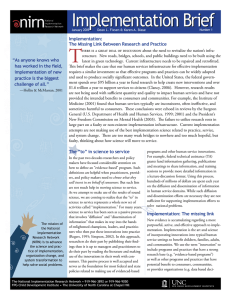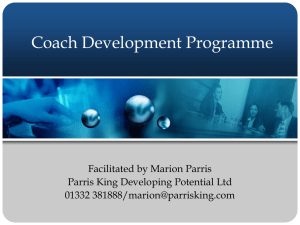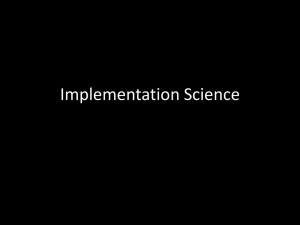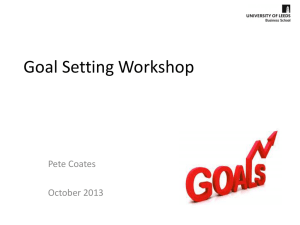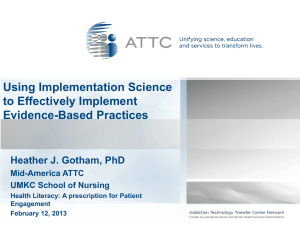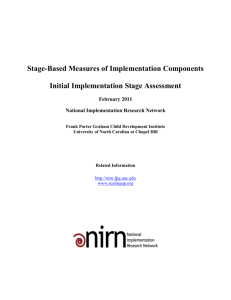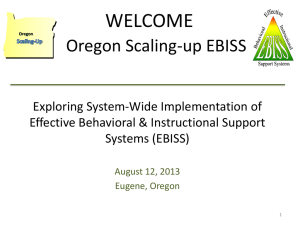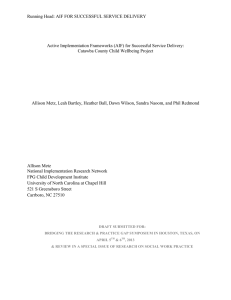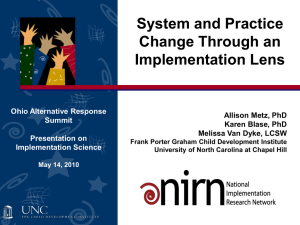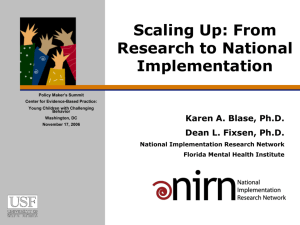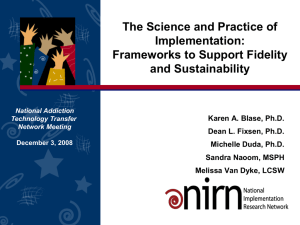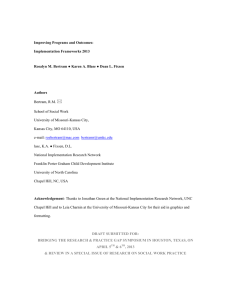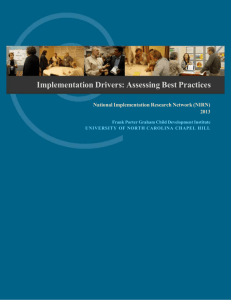RtI_Best_Practices-Implementation_for_a_Change
advertisement
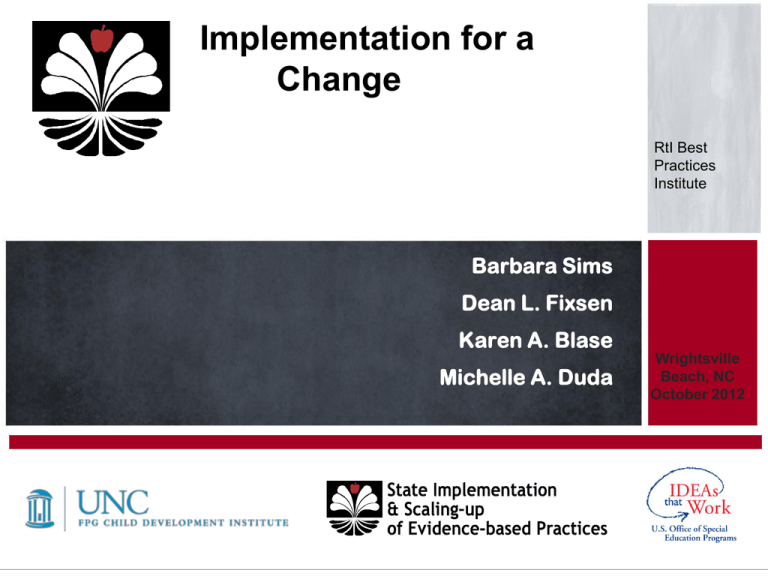
Implementation for a Change RtI Best Practices Institute Barbara Sims Dean L. Fixsen Karen A. Blase Michelle A. Duda Wrightsville Beach, NC October 2012 Complex Problems Human services involve interaction-based sciences Inherently more complex than atom-based sciences E.g., atom-based ingredients don’t refuse to be ingested, talk back, or run away Ineffective Approaches Best data show these methods, when used alone, Do Not result in uses of innovations as intended: Diffusion/ Dissemination of information Training Passing laws/ mandates/ regulations Providing funding/ incentives Organization change/ reorganization 5 to 10% return on investment NECESSARY BUT NOT SUFFICIENT System Change EXISTING SYSTEM EXISTING SYSTEM IS CHANGED TO SUPPORT THE EFFECTIVENESS OF THE INNOVATION EFFECTIVE INNOVATIONS ARE CHANGED TO FIT THE SYSTEM EFFECTIVE INNOVATION Implementation Gap Implementation is defined as a specified set of activities designed to put into practice an activity or program of known dimensions. RESEARCH PRACTICE GAP IMPLEMENTATION Why Focus on Implementation? “Students cannot benefit from interventions they do not experience.” Developing the Capacity to Implement Well “A serious deficiency is the lack of expertise to implement best practices and innovations effectively and efficiently to improve student outcomes.” Rhim, Kowal, Hassel, & Hassel (2007) Implementation Science Implementation science is the scientific study of variables and conditions that impact changes at practice, organization, and systems levels; changes that are required to promote the systematic uptake, sustainability and effective use of evidence-based programs and practices in typical service and social settings. ~Blase and Fixsen, 2010 National Implementation Research Network Implementation Science IMPLEMENTATION INTERVENTION Effective Effective NOT Effective from Mark Lipsey’s 2009 MetaanalyticInconsistent; overview of the primary factors that effective Notcharacterize Sustainable; juvenile offender interventions – Actual outcomes Benefits“. . . inPoor some analyses, the quality with which the intervention is implemented Unpredictable or Poor outcomes; has been as strongly related NOT Effective poor outcomes; to recidivism Sometimes effects harmful as the type of program, so much so that a well-implemented intervention ofon an inherently (Institute of Medicine, 2000; 2001; 2009; New Freedom Commission Mental Health, 2003; National Commission on Excellence in Education, less efficacious type can 1983; Department of Health and Human Services, 1999) outperform a more efficacious one that is poorly implemented.” Formula for Success Effective Intervention practices X 1.0 X Effective Implementation practices 0.0 = Improved Outcomes = 0.0 Plan for Change District is the point of entry for systemic support of school improvement Use short-term infusion of resources Establish long-term, district-based capacity for quality Shifting Accountability Student SISEP 2012 Practitioner System Cascading Logic Model Improve student outcomes Improve teacher instruction Improve school supports for teachers Improve district supports for schools Improve regional supports for districts Improve State supports for outcomes Re-define relationships among system components Focus fully on student outcomes Active Implementation Frameworks Implementation Drivers Implementation Stages Implementation Teams Improvement Cycles Active Implementation Frameworks Successful implementation on a useful scale requires. . . Active use of implementation core components “best practices”– “IMPLEMENTATION DRIVERS” Purposeful matching of critical implementation activities to the stage of the process – “STAGES OF IMPLEMENTATION” Organized, expert assistance – “IMPLEMENTATION TEAMS” A focus on continuous, purposeful improvement – “IMPROVEMENT CYCLES” IMPLEMENTATION DRIVERS Common features of successful supports to help make full and effective use of a wide variety of innovations Improved educational outcomes Consistent Use of Educational Innovations Interventions meet Implementation Performance Assessment (Fidelity) Systems Intervention Coaching Facilitative Administration Training Selection Integrated & Compensatory Decision Support Data System Leadership Adaptive Technical © Fixsen & Blase, 2008 Performance Assessment (Fidelity) Coaching Training Selection Technical © Fixsen & Blase, 2008 © Fixsen & Blase, 2008 Competency Drivers Build Competency and Confidence Develop, improve, and sustain competent & confident use of innovations Performance Assessment Measure fidelity Ensure implementation Reinforce staff and build on strengths Feedback to agency on functioning of Recruitment and Selection Practices Training Programs (pre and in-service) Supervision and Coaching Systems Interpretation of Outcome Data Selection Select for the “unteachables” Screen for pre-requisites Set expectations Allow for mutual selection Improve likelihood of retention after “investment” Improve likelihood that training, coaching, and supervision will result in implementation Training Develop Training Plan Define critical components Aspects requiring new knowledge Aspects requiring new skills Prioritize training topics Identify or develop fidelity measures Coaching Develop Coaching Plan Grounded in “Best Practices” Ensures fidelity Ensures implementation Provides feedback to selection and training processes Training and Coaching OUTCOMES % of Participants who Demonstrate Knowledge, Demonstrate New Skills in a Training Setting, and Use new Skills in the Classroom Knowledge Skill Demonstration Theory and Discussion 10% 5% 0% ..+Demonstration in Training 30% 20% 0% …+ Practice & Feedback in Training 60% 60% 5% …+ Coaching in Classroom 95% 95% 95% TRAINING COMPONENTS Joyce and Showers, 2002 Use in the Classroom Performance Assessment (Fidelity) Systems Intervention Coaching Training Facilitative Administration Decision Support Data System Selection Leadership Adaptive Technical © Fixsen & Blase, 2008 Reflection Supporting New Ways of Work Implementation Drivers How do we support the development of the infrastructure needed to implement well? How do we promote more hospitable organizational environments? How relevant are leadership issues? What’s our role? Active Implementation Frameworks Successful implementation on a useful scale requires. . . Active use of implementation core components “best practices”– “IMPLEMENTATION DRIVERS” Purposeful matching of critical implementation activities to the stage of the process – “STAGES OF IMPLEMENTATION” Organized, expert assistance – “IMPLEMENTATION TEAMS” A focus on continuous, purposeful improvement – “IMPROVEMENT CYCLES” STAGES OF IMPLEMENTATION Purposeful matching of critical implementation activities to the stage of the process SISEP 2012 FULL IMPLEMENTATION 2-4 Years Integrated & Compensatory Leadership EXPLORATION Stages of Implementation Fixsen, Naoom, Blase, Friedman, & Wallace, 2005 Exploration Formalize Team Structures Develop Communication Plan Determine Need and Identify Options Assess “Fit” and Feasibility Promote “Buy in” for the innovation and for implementation supports “Pay now or pay later.” Installation Structural and functional changes are made Establish communication links and protocols First implementers selected Define and initiate training of first implementers Develop coaching plans Evaluate readiness and sustainability of data systems Initial Implementation Initiate training plan Provide coaching Make use of improvement cycles Communication links and protocols PDSA to resolve systems issues Usability testing of selection, training and coaching Full Implementation Skillful practices by all staff Evaluation for expected outcomes Full use of Implementation Drivers Policy changes/development for sustainability “The only thing worse than failing and not knowing why you failed, is succeeding and not knowing why you succeeded.” ~ Jane Timmons-Mitchell ACTIVITY Supporting New Ways of Work Stages of Implementation Analysis • What are you already doing that is “stage-based”? • What are the facilitators and barriers to doing stage-based work? • Discuss the Exploration and Installation Stage indicators. Active Implementation Frameworks Successful implementation on a useful scale requires. . . Active use of implementation core components “best practices”– “IMPLEMENTATION DRIVERS” Purposeful matching of critical implementation activities to the stage of the process – “STAGES OF IMPLEMENTATION” Organized, expert assistance – “IMPLEMENTATION TEAMS” A focus on continuous, purposeful improvement – “IMPROVEMENT CYCLES” IMPLEMENTATION TEAMS Organized, expert assistance to develop and sustain an accountable structure Implementation Team IMPLEMENTATION INTERVENTION Impl. Team Effective NO Impl. Team 80%, 3 Yrs 14%, 17 Yrs Making it Happen Letting it Happen Helping it Happen Fixsen, Blase, Timbers, & Wolf, 2001 Balas & Boren, 2000 Green & Seifert, 2005 Linked Team Structures State-based Implementation Team Regionally-based Implementation Team District-based Implementation Team School-based Implementation Team “We tend to focus on snapshots of isolated parts of the system and wonder why our deepest problems never seem to get solved. (Senge, 1990) ACTIVITY Supporting New Ways of Work Table Talk: Implementation Teams • In your experience, who supports the change process? • How is the transition made from external expertise to building internal capacity? Active Implementation Frameworks Successful implementation on a useful scale requires. . . Active use of implementation core components “best practices”– “IMPLEMENTATION DRIVERS” Purposeful matching of critical implementation activities to the stage of the process – “STAGES OF IMPLEMENTATION” Organized, expert assistance – “IMPLEMENTATION TEAMS” A focus on continuous, purposeful improvement – “IMPROVEMENT CYCLES” IMPROVEMENT CYCLES Changing on purpose to support the new way of work SISEP 2012 Types of Improvement Cycles Plan-Do-Study-Act Cycles Usability testing (Neilson; Rubin) Practice-policy communication loops PDSA Usability Testing Policy Practice Feedback Loops Policy Policy Enabled Practices (PEP) Feedback Practice Informed Policy (PIP) Study - Act Expert Implementation Support Policy (Plan) Structure Procedure Practice (Do) FORM SUPPORTS FUNCTION Practice ACTIVITY Supporting New Ways of Work Table Talk: Improvement Cycles and Communication Loops • How can we make use of improvement cycles in developing and implementing our improvement activities? • Linking Communication Protocols Summary Conceptualize a change process so that effective interventions for children and families can become embedded and sustained in socially complex settings Improvement processes are critical “stage-matched activities to guide the process “implementation drivers” to build the infrastructure the work is never done because the environment is in motion Invest in the development of organized, “expert” implementation support Stay Connected! www.scalingup.org @SISEPcenter SISEP For more on Implementation Science http://nirn.fpg.unc.edu www.implementationconference.org
